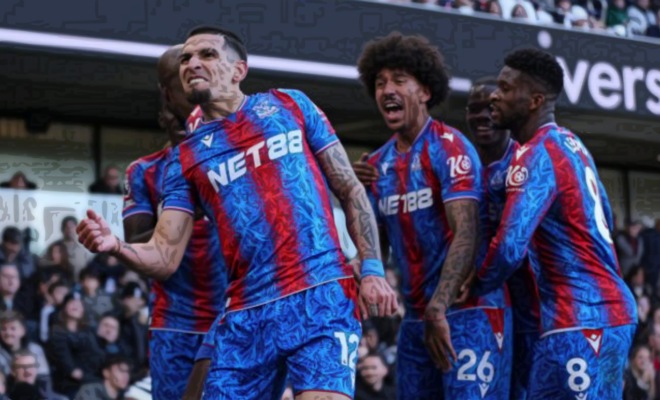Midfield Matters: How Arsenal Can Emulate Crystal Palace’s Success in Disrupting the Opposition

In a Premier League encounter that defied expectations, Crystal Palace orchestrated a masterful 2-0 victory against Fulham at Craven Cottage. Beyond the scoreline, the match unveiled a tactical blueprint centered around a highly effective midfield performance, orchestrated by Will Hughes, that stifled Fulham’s creativity and dictated the flow of the game. This performance prompts a crucial question for Arsenal: can they emulate Crystal Palace’s midfield strategy to enhance their own ability to disrupt opponents and control matches?
Fulham’s Frustration: A Midfield Misfire?
Fulham, heading into the match on the back of consecutive league victories, appeared poised to continue their push for European qualification. However, from the onset, Marco Silva’s side struggled to impose their will on the game. Reports suggest that Fulham failed to capitalize on their efforts to qualify for Europe after wins against Newcastle and Nottingham Forest. Despite enjoying a significant share of possession – exceeding 60% for much of the game – Fulham’s midfield lacked the dynamism and incisiveness needed to unlock Crystal Palace’s defense.
Several factors contributed to Fulham’s midfield woes:
- Lack of Creativity: Fulham’s key playmakers, including Alex Iwobi, were effectively neutralized by Crystal Palace’s disciplined midfield structure.
- Ineffective Pressing: Fulham struggled to win back possession in crucial areas, allowing Crystal Palace to launch swift counter-attacks.
- Defensive Vulnerability: Fulham’s midfield was often exposed defensively, failing to provide adequate protection to the back four.
Hughes’ Heroics: A Masterclass in Midfield Disruption
At the heart of Crystal Palace’s success was the performance of Will Hughes. Deployed in a deep-lying midfield role, Hughes acted as a lynchpin, breaking up Fulham’s attacks, dictating the tempo of his own team’s play, and providing a shield for the Crystal Palace defense.
Hughes’ impact can be attributed to several key attributes:
- Tactical Intelligence: Hughes demonstrated a keen understanding of the game, consistently making the right decisions in terms of positioning, tackling, and passing.
- Work Rate and Determination: Hughes covered every blade of grass, tirelessly tracking runners, closing down space, and winning tackles.
- Composure in Possession: Hughes was composed and assured on the ball, rarely relinquishing possession and always looking to play forward when possible.
- Breaking up play: According to reports, Hughes was excellent at the base of midfield, breaking up play and getting his team ticking.
- Protecting the Backline: Reports indicate that Hughes protected a backline that had virtually nothing to do all afternoon with aplomb.
Glasner’s Gambit: Tactical Masterclass
Crystal Palace’s victory was not solely down to individual brilliance; it was also a testament to Oliver Glasner’s tactical acumen. Glasner recognized Fulham’s strengths and weaknesses and devised a game plan that effectively exploited them.
Key elements of Glasner’s strategy included:
- Compact Defensive Shape: Crystal Palace maintained a tight and disciplined defensive shape, making it difficult for Fulham to penetrate their lines.
- Midfield Press: Crystal Palace’s midfield pressed Fulham aggressively in key areas, forcing turnovers and disrupting their rhythm.
- Counter-Attacking Prowess: Crystal Palace was quick and decisive on the counter-attack, exploiting the space left behind by Fulham’s attacking players.
- Team discipline: According to reports, Oliver Glasner noted that all of the credit goes to the players again, they worked so hard for this win and they were very disciplined.
Arsenal’s Midfield Equation: Seeking the Missing Piece
Arsenal, under Mikel Arteta, have established themselves as one of the Premier League’s most exciting and dynamic attacking teams. However, their midfield has occasionally been criticized for lacking the physicality and disruption needed to consistently dominate games against strong opponents.
While Arsenal boasts talented midfielders such as Declan Rice, Martin Odegaard, and Emile Smith Rowe, they could benefit from adding a player with the attributes of Will Hughes – a tenacious, tactically astute, and defensively responsible midfielder who can break up play, protect the back four, and initiate counter-attacks.
Potential Solutions: Internal and External
Arsenal has several options for addressing their midfield needs, both internally and externally:
- Developing Existing Talent: Arsenal could focus on developing the defensive aspects of existing midfielders, such as Albert Sambi Lokonga or Charlie Patino. By improving their tackling, positioning, and tactical awareness, these players could potentially evolve into more disruptive midfielders.
- Recruiting a Specialist: Arsenal could look to recruit a specialist defensive midfielder in the transfer market. There are several players in Europe who possess the attributes needed to excel in this role.
- Adapting Existing Players: Arsenal may consider working with players they have to see if they can take on additional duties.
Tactical Tweaks: Emulating Crystal Palace’s Approach
In addition to personnel changes, Arsenal could also emulate Crystal Palace’s tactical approach to enhance their midfield disruption. This could involve:
- Implementing a More Aggressive Press: Arsenal could adopt a more aggressive pressing strategy in midfield, aiming to win back possession higher up the pitch and disrupt the opponent’s build-up play.
- Prioritizing Defensive Solidity: Arsenal could prioritize defensive solidity in midfield, ensuring that the two central midfielders provide adequate protection to the back four.
- Utilizing a Double Pivot: Arsenal could experiment with a double pivot in midfield, pairing a more creative player with a dedicated defensive midfielder.
- Adapting tactics: Arsenal could take lessons from Oliver Glasner’s approach with Crystal Palace.
The Importance of Balance: Attack and Defense
It’s important to note that Arsenal’s midfield strategy must strike a balance between attack and defense. While disruption and physicality are important, Arsenal cannot afford to sacrifice their creativity and attacking flair.
The ideal scenario would be to find a midfielder who possesses both defensive steel and the ability to contribute to the team’s attacking play. This would allow Arsenal to maintain their attacking threat while also becoming more difficult to play against.
A Test for the Gunners
Crystal Palace’s victory over Fulham provided a blueprint for how a well-organized and disciplined midfield can stifle the opposition and control the flow of the game. For Arsenal, emulating Crystal Palace’s success in midfield disruption represents a significant opportunity to enhance their own tactical flexibility and become a more complete team.
By developing existing talent, recruiting a specialist, and implementing tactical tweaks, Arsenal can create a midfield that is not only creative and dynamic but also tenacious, tactically astute, and defensively responsible. This would make them an even more formidable force in the Premier League and increase their chances of achieving their ultimate goal: winning the title.







